Becoming a Teacher: Case Study - Theories, Strategies, and Analysis
VerifiedAdded on 2020/01/28
|8
|3191
|63
Case Study
AI Summary
This case study explores the process of becoming a teacher, focusing on the application of various educational theories and teaching strategies within a science curriculum, specifically mathematics at the GCSE level. The essay examines real and imaginary approaches to teaching, emphasizing the importance of real-world examples and practical experience. It delves into the theories of Skinner, Vygotsky, Bruner, and Piaget, analyzing their implications for classroom practice and student learning. The study highlights the importance of understanding individual student needs and creating an emotionally safe learning environment. Furthermore, it emphasizes the effectiveness of formative assessments in monitoring student progress and adapting teaching methods. The case study provides a comprehensive overview of the key aspects involved in teacher development and effective pedagogy.
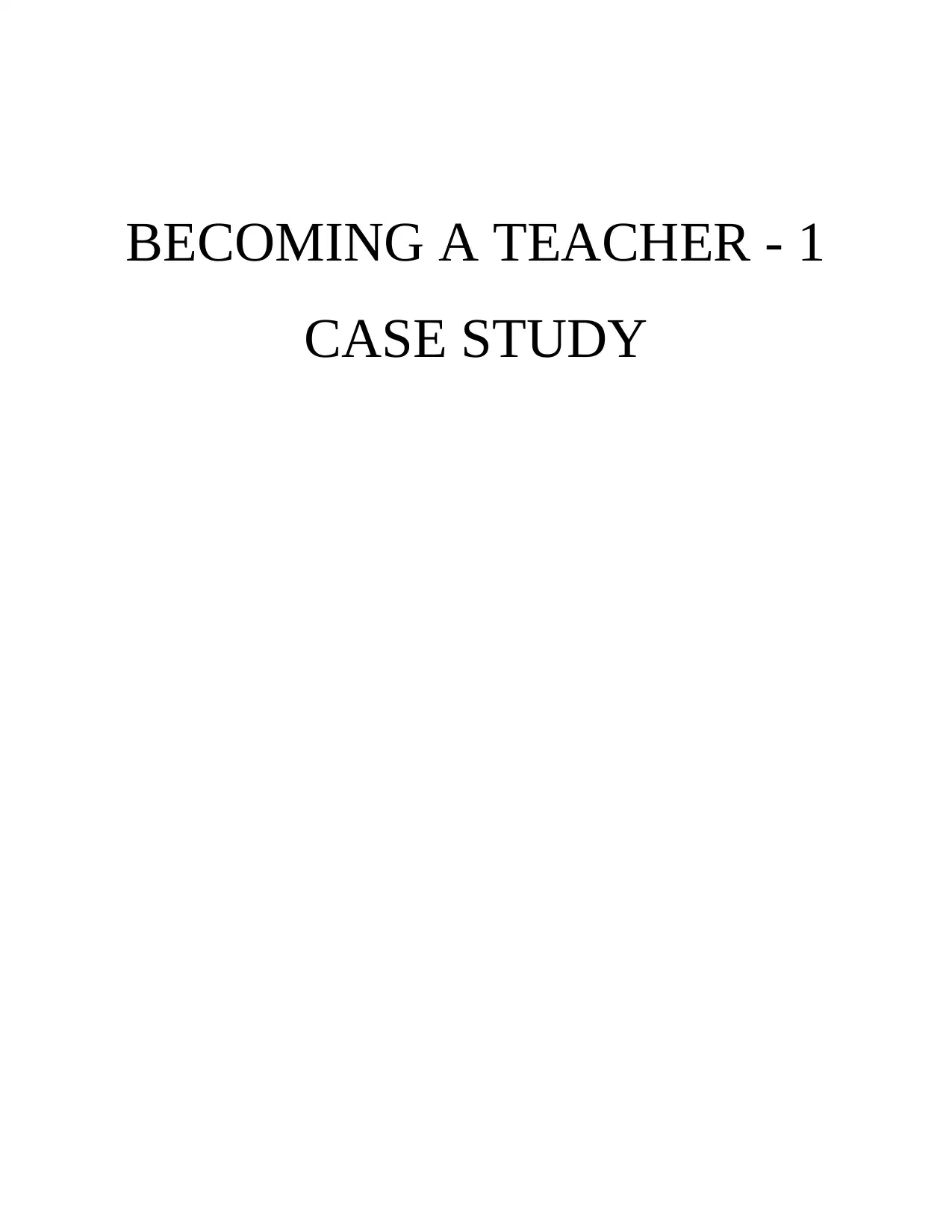
BECOMING A TEACHER - 1
CASE STUDY
CASE STUDY
Paraphrase This Document
Need a fresh take? Get an instant paraphrase of this document with our AI Paraphraser
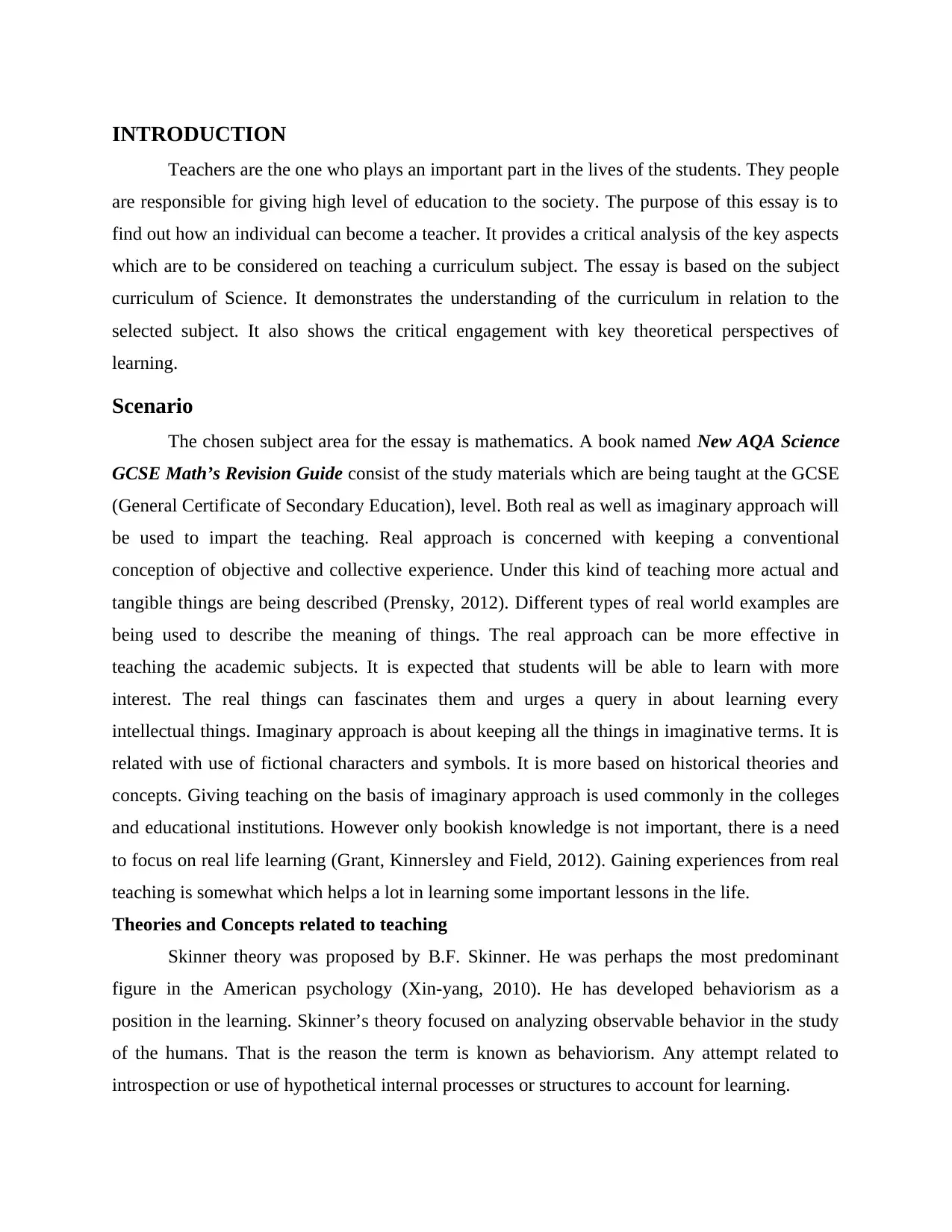
INTRODUCTION
Teachers are the one who plays an important part in the lives of the students. They people
are responsible for giving high level of education to the society. The purpose of this essay is to
find out how an individual can become a teacher. It provides a critical analysis of the key aspects
which are to be considered on teaching a curriculum subject. The essay is based on the subject
curriculum of Science. It demonstrates the understanding of the curriculum in relation to the
selected subject. It also shows the critical engagement with key theoretical perspectives of
learning.
Scenario
The chosen subject area for the essay is mathematics. A book named New AQA Science
GCSE Math’s Revision Guide consist of the study materials which are being taught at the GCSE
(General Certificate of Secondary Education), level. Both real as well as imaginary approach will
be used to impart the teaching. Real approach is concerned with keeping a conventional
conception of objective and collective experience. Under this kind of teaching more actual and
tangible things are being described (Prensky, 2012). Different types of real world examples are
being used to describe the meaning of things. The real approach can be more effective in
teaching the academic subjects. It is expected that students will be able to learn with more
interest. The real things can fascinates them and urges a query in about learning every
intellectual things. Imaginary approach is about keeping all the things in imaginative terms. It is
related with use of fictional characters and symbols. It is more based on historical theories and
concepts. Giving teaching on the basis of imaginary approach is used commonly in the colleges
and educational institutions. However only bookish knowledge is not important, there is a need
to focus on real life learning (Grant, Kinnersley and Field, 2012). Gaining experiences from real
teaching is somewhat which helps a lot in learning some important lessons in the life.
Theories and Concepts related to teaching
Skinner theory was proposed by B.F. Skinner. He was perhaps the most predominant
figure in the American psychology (Xin-yang, 2010). He has developed behaviorism as a
position in the learning. Skinner’s theory focused on analyzing observable behavior in the study
of the humans. That is the reason the term is known as behaviorism. Any attempt related to
introspection or use of hypothetical internal processes or structures to account for learning.
Teachers are the one who plays an important part in the lives of the students. They people
are responsible for giving high level of education to the society. The purpose of this essay is to
find out how an individual can become a teacher. It provides a critical analysis of the key aspects
which are to be considered on teaching a curriculum subject. The essay is based on the subject
curriculum of Science. It demonstrates the understanding of the curriculum in relation to the
selected subject. It also shows the critical engagement with key theoretical perspectives of
learning.
Scenario
The chosen subject area for the essay is mathematics. A book named New AQA Science
GCSE Math’s Revision Guide consist of the study materials which are being taught at the GCSE
(General Certificate of Secondary Education), level. Both real as well as imaginary approach will
be used to impart the teaching. Real approach is concerned with keeping a conventional
conception of objective and collective experience. Under this kind of teaching more actual and
tangible things are being described (Prensky, 2012). Different types of real world examples are
being used to describe the meaning of things. The real approach can be more effective in
teaching the academic subjects. It is expected that students will be able to learn with more
interest. The real things can fascinates them and urges a query in about learning every
intellectual things. Imaginary approach is about keeping all the things in imaginative terms. It is
related with use of fictional characters and symbols. It is more based on historical theories and
concepts. Giving teaching on the basis of imaginary approach is used commonly in the colleges
and educational institutions. However only bookish knowledge is not important, there is a need
to focus on real life learning (Grant, Kinnersley and Field, 2012). Gaining experiences from real
teaching is somewhat which helps a lot in learning some important lessons in the life.
Theories and Concepts related to teaching
Skinner theory was proposed by B.F. Skinner. He was perhaps the most predominant
figure in the American psychology (Xin-yang, 2010). He has developed behaviorism as a
position in the learning. Skinner’s theory focused on analyzing observable behavior in the study
of the humans. That is the reason the term is known as behaviorism. Any attempt related to
introspection or use of hypothetical internal processes or structures to account for learning.
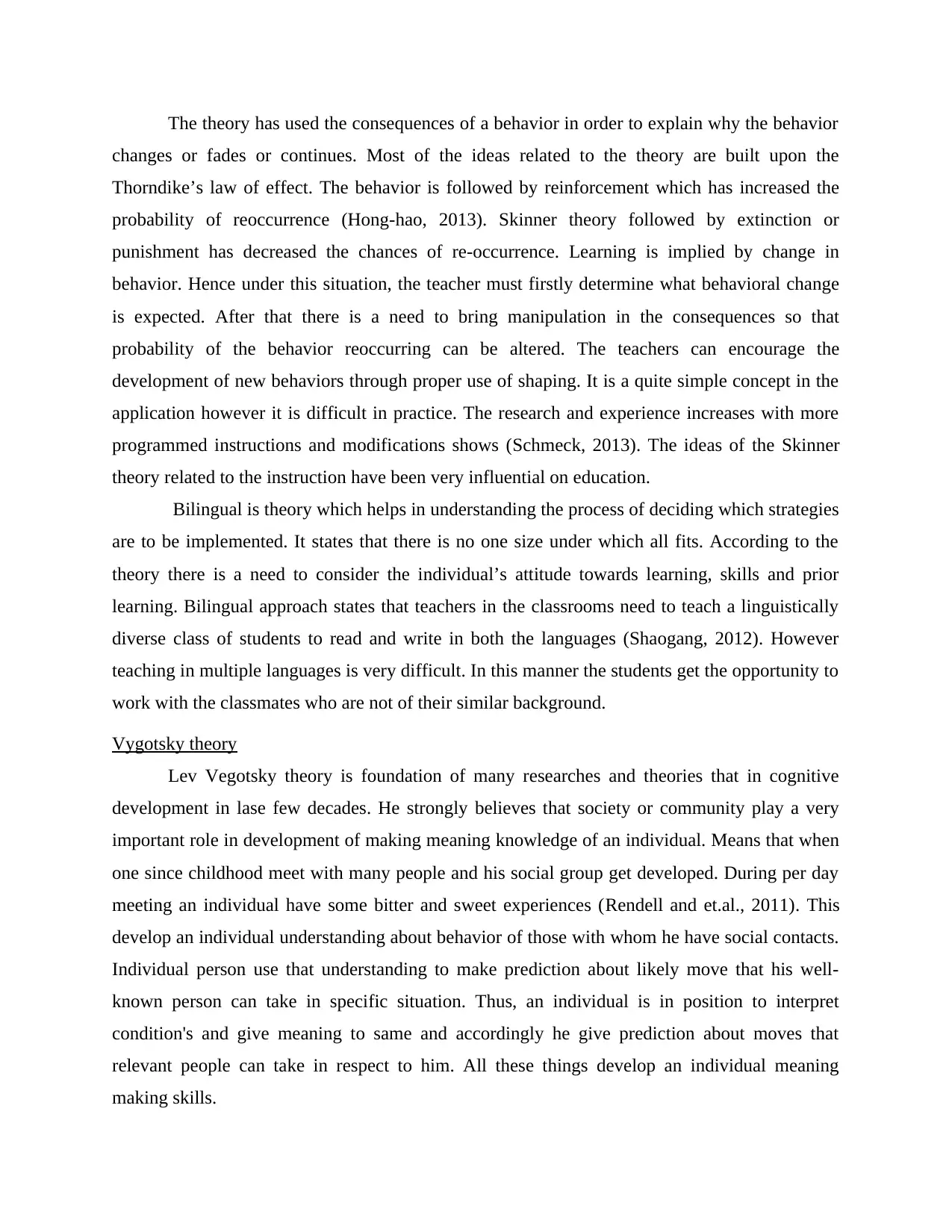
The theory has used the consequences of a behavior in order to explain why the behavior
changes or fades or continues. Most of the ideas related to the theory are built upon the
Thorndike’s law of effect. The behavior is followed by reinforcement which has increased the
probability of reoccurrence (Hong-hao, 2013). Skinner theory followed by extinction or
punishment has decreased the chances of re-occurrence. Learning is implied by change in
behavior. Hence under this situation, the teacher must firstly determine what behavioral change
is expected. After that there is a need to bring manipulation in the consequences so that
probability of the behavior reoccurring can be altered. The teachers can encourage the
development of new behaviors through proper use of shaping. It is a quite simple concept in the
application however it is difficult in practice. The research and experience increases with more
programmed instructions and modifications shows (Schmeck, 2013). The ideas of the Skinner
theory related to the instruction have been very influential on education.
Bilingual is theory which helps in understanding the process of deciding which strategies
are to be implemented. It states that there is no one size under which all fits. According to the
theory there is a need to consider the individual’s attitude towards learning, skills and prior
learning. Bilingual approach states that teachers in the classrooms need to teach a linguistically
diverse class of students to read and write in both the languages (Shaogang, 2012). However
teaching in multiple languages is very difficult. In this manner the students get the opportunity to
work with the classmates who are not of their similar background.
Vygotsky theory
Lev Vegotsky theory is foundation of many researches and theories that in cognitive
development in lase few decades. He strongly believes that society or community play a very
important role in development of making meaning knowledge of an individual. Means that when
one since childhood meet with many people and his social group get developed. During per day
meeting an individual have some bitter and sweet experiences (Rendell and et.al., 2011). This
develop an individual understanding about behavior of those with whom he have social contacts.
Individual person use that understanding to make prediction about likely move that his well-
known person can take in specific situation. Thus, an individual is in position to interpret
condition's and give meaning to same and accordingly he give prediction about moves that
relevant people can take in respect to him. All these things develop an individual meaning
making skills.
changes or fades or continues. Most of the ideas related to the theory are built upon the
Thorndike’s law of effect. The behavior is followed by reinforcement which has increased the
probability of reoccurrence (Hong-hao, 2013). Skinner theory followed by extinction or
punishment has decreased the chances of re-occurrence. Learning is implied by change in
behavior. Hence under this situation, the teacher must firstly determine what behavioral change
is expected. After that there is a need to bring manipulation in the consequences so that
probability of the behavior reoccurring can be altered. The teachers can encourage the
development of new behaviors through proper use of shaping. It is a quite simple concept in the
application however it is difficult in practice. The research and experience increases with more
programmed instructions and modifications shows (Schmeck, 2013). The ideas of the Skinner
theory related to the instruction have been very influential on education.
Bilingual is theory which helps in understanding the process of deciding which strategies
are to be implemented. It states that there is no one size under which all fits. According to the
theory there is a need to consider the individual’s attitude towards learning, skills and prior
learning. Bilingual approach states that teachers in the classrooms need to teach a linguistically
diverse class of students to read and write in both the languages (Shaogang, 2012). However
teaching in multiple languages is very difficult. In this manner the students get the opportunity to
work with the classmates who are not of their similar background.
Vygotsky theory
Lev Vegotsky theory is foundation of many researches and theories that in cognitive
development in lase few decades. He strongly believes that society or community play a very
important role in development of making meaning knowledge of an individual. Means that when
one since childhood meet with many people and his social group get developed. During per day
meeting an individual have some bitter and sweet experiences (Rendell and et.al., 2011). This
develop an individual understanding about behavior of those with whom he have social contacts.
Individual person use that understanding to make prediction about likely move that his well-
known person can take in specific situation. Thus, an individual is in position to interpret
condition's and give meaning to same and accordingly he give prediction about moves that
relevant people can take in respect to him. All these things develop an individual meaning
making skills.
⊘ This is a preview!⊘
Do you want full access?
Subscribe today to unlock all pages.

Trusted by 1+ million students worldwide
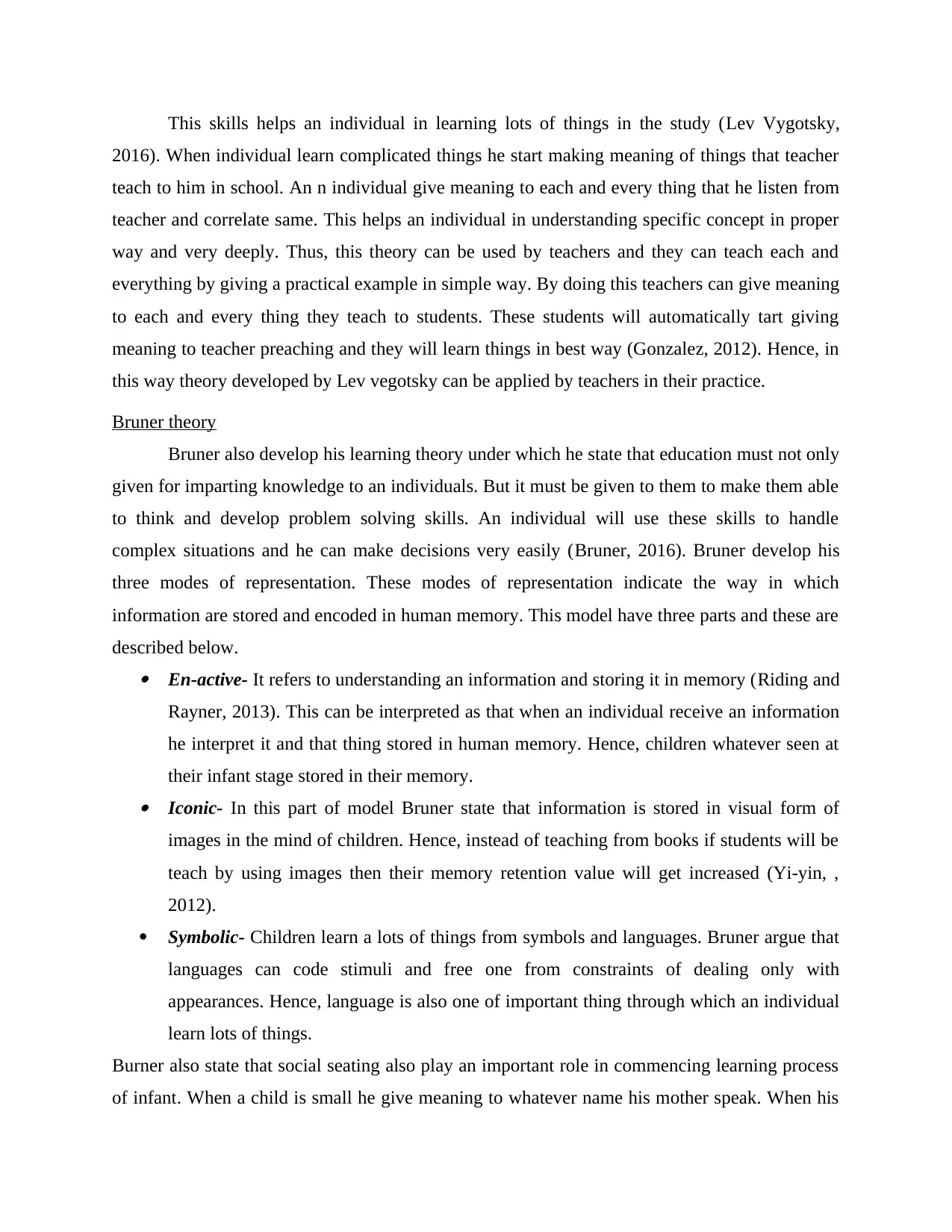
This skills helps an individual in learning lots of things in the study (Lev Vygotsky,
2016). When individual learn complicated things he start making meaning of things that teacher
teach to him in school. An n individual give meaning to each and every thing that he listen from
teacher and correlate same. This helps an individual in understanding specific concept in proper
way and very deeply. Thus, this theory can be used by teachers and they can teach each and
everything by giving a practical example in simple way. By doing this teachers can give meaning
to each and every thing they teach to students. These students will automatically tart giving
meaning to teacher preaching and they will learn things in best way (Gonzalez, 2012). Hence, in
this way theory developed by Lev vegotsky can be applied by teachers in their practice.
Bruner theory
Bruner also develop his learning theory under which he state that education must not only
given for imparting knowledge to an individuals. But it must be given to them to make them able
to think and develop problem solving skills. An individual will use these skills to handle
complex situations and he can make decisions very easily (Bruner, 2016). Bruner develop his
three modes of representation. These modes of representation indicate the way in which
information are stored and encoded in human memory. This model have three parts and these are
described below. En-active- It refers to understanding an information and storing it in memory (Riding and
Rayner, 2013). This can be interpreted as that when an individual receive an information
he interpret it and that thing stored in human memory. Hence, children whatever seen at
their infant stage stored in their memory. Iconic- In this part of model Bruner state that information is stored in visual form of
images in the mind of children. Hence, instead of teaching from books if students will be
teach by using images then their memory retention value will get increased (Yi-yin, ,
2012).
Symbolic- Children learn a lots of things from symbols and languages. Bruner argue that
languages can code stimuli and free one from constraints of dealing only with
appearances. Hence, language is also one of important thing through which an individual
learn lots of things.
Burner also state that social seating also play an important role in commencing learning process
of infant. When a child is small he give meaning to whatever name his mother speak. When his
2016). When individual learn complicated things he start making meaning of things that teacher
teach to him in school. An n individual give meaning to each and every thing that he listen from
teacher and correlate same. This helps an individual in understanding specific concept in proper
way and very deeply. Thus, this theory can be used by teachers and they can teach each and
everything by giving a practical example in simple way. By doing this teachers can give meaning
to each and every thing they teach to students. These students will automatically tart giving
meaning to teacher preaching and they will learn things in best way (Gonzalez, 2012). Hence, in
this way theory developed by Lev vegotsky can be applied by teachers in their practice.
Bruner theory
Bruner also develop his learning theory under which he state that education must not only
given for imparting knowledge to an individuals. But it must be given to them to make them able
to think and develop problem solving skills. An individual will use these skills to handle
complex situations and he can make decisions very easily (Bruner, 2016). Bruner develop his
three modes of representation. These modes of representation indicate the way in which
information are stored and encoded in human memory. This model have three parts and these are
described below. En-active- It refers to understanding an information and storing it in memory (Riding and
Rayner, 2013). This can be interpreted as that when an individual receive an information
he interpret it and that thing stored in human memory. Hence, children whatever seen at
their infant stage stored in their memory. Iconic- In this part of model Bruner state that information is stored in visual form of
images in the mind of children. Hence, instead of teaching from books if students will be
teach by using images then their memory retention value will get increased (Yi-yin, ,
2012).
Symbolic- Children learn a lots of things from symbols and languages. Bruner argue that
languages can code stimuli and free one from constraints of dealing only with
appearances. Hence, language is also one of important thing through which an individual
learn lots of things.
Burner also state that social seating also play an important role in commencing learning process
of infant. When a child is small he give meaning to whatever name his mother speak. When his
Paraphrase This Document
Need a fresh take? Get an instant paraphrase of this document with our AI Paraphraser
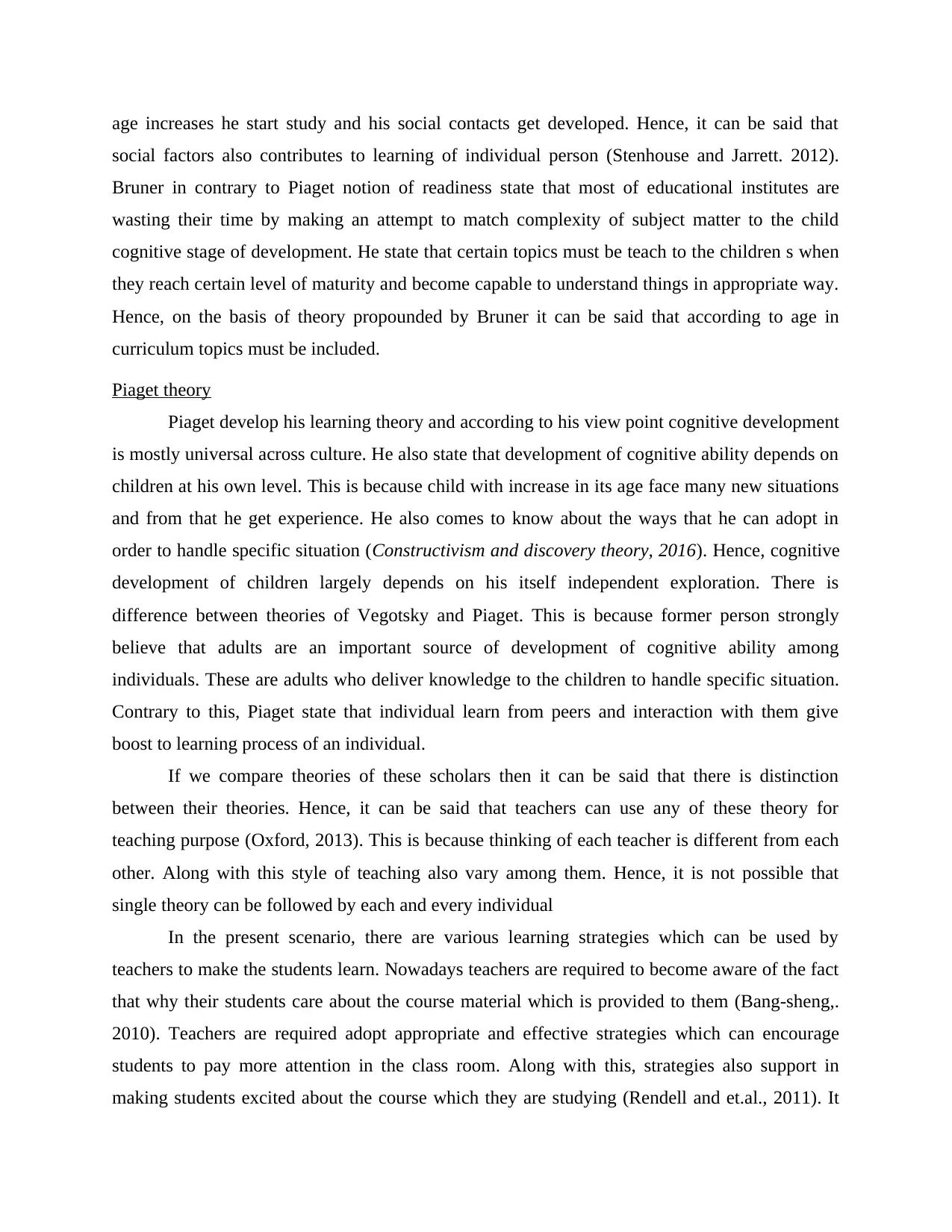
age increases he start study and his social contacts get developed. Hence, it can be said that
social factors also contributes to learning of individual person (Stenhouse and Jarrett. 2012).
Bruner in contrary to Piaget notion of readiness state that most of educational institutes are
wasting their time by making an attempt to match complexity of subject matter to the child
cognitive stage of development. He state that certain topics must be teach to the children s when
they reach certain level of maturity and become capable to understand things in appropriate way.
Hence, on the basis of theory propounded by Bruner it can be said that according to age in
curriculum topics must be included.
Piaget theory
Piaget develop his learning theory and according to his view point cognitive development
is mostly universal across culture. He also state that development of cognitive ability depends on
children at his own level. This is because child with increase in its age face many new situations
and from that he get experience. He also comes to know about the ways that he can adopt in
order to handle specific situation (Constructivism and discovery theory, 2016). Hence, cognitive
development of children largely depends on his itself independent exploration. There is
difference between theories of Vegotsky and Piaget. This is because former person strongly
believe that adults are an important source of development of cognitive ability among
individuals. These are adults who deliver knowledge to the children to handle specific situation.
Contrary to this, Piaget state that individual learn from peers and interaction with them give
boost to learning process of an individual.
If we compare theories of these scholars then it can be said that there is distinction
between their theories. Hence, it can be said that teachers can use any of these theory for
teaching purpose (Oxford, 2013). This is because thinking of each teacher is different from each
other. Along with this style of teaching also vary among them. Hence, it is not possible that
single theory can be followed by each and every individual
In the present scenario, there are various learning strategies which can be used by
teachers to make the students learn. Nowadays teachers are required to become aware of the fact
that why their students care about the course material which is provided to them (Bang-sheng,.
2010). Teachers are required adopt appropriate and effective strategies which can encourage
students to pay more attention in the class room. Along with this, strategies also support in
making students excited about the course which they are studying (Rendell and et.al., 2011). It
social factors also contributes to learning of individual person (Stenhouse and Jarrett. 2012).
Bruner in contrary to Piaget notion of readiness state that most of educational institutes are
wasting their time by making an attempt to match complexity of subject matter to the child
cognitive stage of development. He state that certain topics must be teach to the children s when
they reach certain level of maturity and become capable to understand things in appropriate way.
Hence, on the basis of theory propounded by Bruner it can be said that according to age in
curriculum topics must be included.
Piaget theory
Piaget develop his learning theory and according to his view point cognitive development
is mostly universal across culture. He also state that development of cognitive ability depends on
children at his own level. This is because child with increase in its age face many new situations
and from that he get experience. He also comes to know about the ways that he can adopt in
order to handle specific situation (Constructivism and discovery theory, 2016). Hence, cognitive
development of children largely depends on his itself independent exploration. There is
difference between theories of Vegotsky and Piaget. This is because former person strongly
believe that adults are an important source of development of cognitive ability among
individuals. These are adults who deliver knowledge to the children to handle specific situation.
Contrary to this, Piaget state that individual learn from peers and interaction with them give
boost to learning process of an individual.
If we compare theories of these scholars then it can be said that there is distinction
between their theories. Hence, it can be said that teachers can use any of these theory for
teaching purpose (Oxford, 2013). This is because thinking of each teacher is different from each
other. Along with this style of teaching also vary among them. Hence, it is not possible that
single theory can be followed by each and every individual
In the present scenario, there are various learning strategies which can be used by
teachers to make the students learn. Nowadays teachers are required to become aware of the fact
that why their students care about the course material which is provided to them (Bang-sheng,.
2010). Teachers are required adopt appropriate and effective strategies which can encourage
students to pay more attention in the class room. Along with this, strategies also support in
making students excited about the course which they are studying (Rendell and et.al., 2011). It

can be also stated that before implementing any kind of strategy, teachers are required to become
aware of need and demand of all their students. Teachers need to develop appropriate goals and
objectives in order to make the student learn more. One of the most effective strategy which can
be used by teachers is of developing an emotionally safe classroom at the time of making the
students learn. It can be stated that effective teaching strategy is the one which encourages all to
learn new things and no one in the class feels neglected or ashamed.
Emotionally safe environment is the one where students are always encouraged to take
risk and even they fail, students do not laugh at each other (Mangram and et.al., 2015). On the
other hand, formative assessment is another effective strategy which can be used to make the
students learn new things and concepts. In last few years, the concept of formative assessment
has become very common among teachers. The rationale behind this is that it helps teachers to
monitor the entire learning process of students and identify the fact that whether they are heading
towards right direction or not. Further, it is helpful for both teachers and for all the students. In
terms of students, formative assessments provide them insight of their core strengths and
weaknesses. It also gives students with clear idea regarding the areas upon which they are
required to work hard (Oxford, 2013). On the other hand, it supports teachers in improving their
overall teaching practises. Teachers can easily use this strategy by taking test and exam of
students after completion of their lesson or unit (Mitra and et.al., 2010). It is also effective in
tracking the overall progress of students and carrying out appropriate changes in teaching
process. After end of lesson or chapter, teachers can use this study to become aware of the fact
that whether the students are clear with the chapter or not. The use of formative assessment also
play very important role in making appropriate adjustments in the way they are delivering
lectures and sessions to the class (Mitra and et.al., 2010). Another strategy which can be used by
teachers for providing knowledge to students is discussions in classrooms. In this strategy,
teachers can ask questions related to the chapter which has been taught in the class. In addition to
this, open session will also allow all students in class to learn from each other. Sometimes, it
happens that students are not able to clear their concept from teachers and they are easily to learn
new things from other students. Taking feedbacks from students is another effective learning
strategy which can be used by teachers. After end of every session or lectures a written or oral
feedback can be taken from students. This will help teachers to become aware of the areas in
which both students and teachers need improvement.
aware of need and demand of all their students. Teachers need to develop appropriate goals and
objectives in order to make the student learn more. One of the most effective strategy which can
be used by teachers is of developing an emotionally safe classroom at the time of making the
students learn. It can be stated that effective teaching strategy is the one which encourages all to
learn new things and no one in the class feels neglected or ashamed.
Emotionally safe environment is the one where students are always encouraged to take
risk and even they fail, students do not laugh at each other (Mangram and et.al., 2015). On the
other hand, formative assessment is another effective strategy which can be used to make the
students learn new things and concepts. In last few years, the concept of formative assessment
has become very common among teachers. The rationale behind this is that it helps teachers to
monitor the entire learning process of students and identify the fact that whether they are heading
towards right direction or not. Further, it is helpful for both teachers and for all the students. In
terms of students, formative assessments provide them insight of their core strengths and
weaknesses. It also gives students with clear idea regarding the areas upon which they are
required to work hard (Oxford, 2013). On the other hand, it supports teachers in improving their
overall teaching practises. Teachers can easily use this strategy by taking test and exam of
students after completion of their lesson or unit (Mitra and et.al., 2010). It is also effective in
tracking the overall progress of students and carrying out appropriate changes in teaching
process. After end of lesson or chapter, teachers can use this study to become aware of the fact
that whether the students are clear with the chapter or not. The use of formative assessment also
play very important role in making appropriate adjustments in the way they are delivering
lectures and sessions to the class (Mitra and et.al., 2010). Another strategy which can be used by
teachers for providing knowledge to students is discussions in classrooms. In this strategy,
teachers can ask questions related to the chapter which has been taught in the class. In addition to
this, open session will also allow all students in class to learn from each other. Sometimes, it
happens that students are not able to clear their concept from teachers and they are easily to learn
new things from other students. Taking feedbacks from students is another effective learning
strategy which can be used by teachers. After end of every session or lectures a written or oral
feedback can be taken from students. This will help teachers to become aware of the areas in
which both students and teachers need improvement.
⊘ This is a preview!⊘
Do you want full access?
Subscribe today to unlock all pages.

Trusted by 1+ million students worldwide
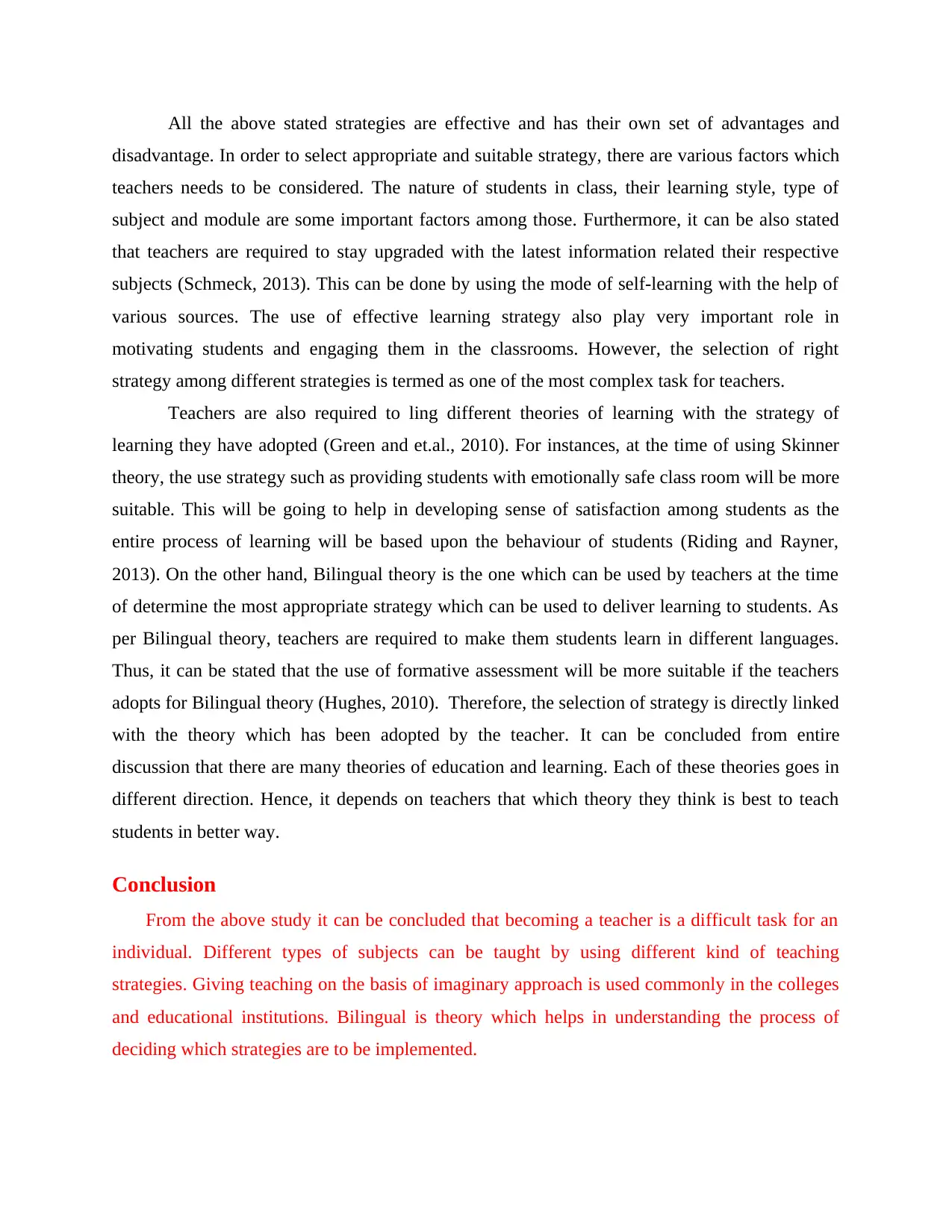
All the above stated strategies are effective and has their own set of advantages and
disadvantage. In order to select appropriate and suitable strategy, there are various factors which
teachers needs to be considered. The nature of students in class, their learning style, type of
subject and module are some important factors among those. Furthermore, it can be also stated
that teachers are required to stay upgraded with the latest information related their respective
subjects (Schmeck, 2013). This can be done by using the mode of self-learning with the help of
various sources. The use of effective learning strategy also play very important role in
motivating students and engaging them in the classrooms. However, the selection of right
strategy among different strategies is termed as one of the most complex task for teachers.
Teachers are also required to ling different theories of learning with the strategy of
learning they have adopted (Green and et.al., 2010). For instances, at the time of using Skinner
theory, the use strategy such as providing students with emotionally safe class room will be more
suitable. This will be going to help in developing sense of satisfaction among students as the
entire process of learning will be based upon the behaviour of students (Riding and Rayner,
2013). On the other hand, Bilingual theory is the one which can be used by teachers at the time
of determine the most appropriate strategy which can be used to deliver learning to students. As
per Bilingual theory, teachers are required to make them students learn in different languages.
Thus, it can be stated that the use of formative assessment will be more suitable if the teachers
adopts for Bilingual theory (Hughes, 2010). Therefore, the selection of strategy is directly linked
with the theory which has been adopted by the teacher. It can be concluded from entire
discussion that there are many theories of education and learning. Each of these theories goes in
different direction. Hence, it depends on teachers that which theory they think is best to teach
students in better way.
Conclusion
From the above study it can be concluded that becoming a teacher is a difficult task for an
individual. Different types of subjects can be taught by using different kind of teaching
strategies. Giving teaching on the basis of imaginary approach is used commonly in the colleges
and educational institutions. Bilingual is theory which helps in understanding the process of
deciding which strategies are to be implemented.
disadvantage. In order to select appropriate and suitable strategy, there are various factors which
teachers needs to be considered. The nature of students in class, their learning style, type of
subject and module are some important factors among those. Furthermore, it can be also stated
that teachers are required to stay upgraded with the latest information related their respective
subjects (Schmeck, 2013). This can be done by using the mode of self-learning with the help of
various sources. The use of effective learning strategy also play very important role in
motivating students and engaging them in the classrooms. However, the selection of right
strategy among different strategies is termed as one of the most complex task for teachers.
Teachers are also required to ling different theories of learning with the strategy of
learning they have adopted (Green and et.al., 2010). For instances, at the time of using Skinner
theory, the use strategy such as providing students with emotionally safe class room will be more
suitable. This will be going to help in developing sense of satisfaction among students as the
entire process of learning will be based upon the behaviour of students (Riding and Rayner,
2013). On the other hand, Bilingual theory is the one which can be used by teachers at the time
of determine the most appropriate strategy which can be used to deliver learning to students. As
per Bilingual theory, teachers are required to make them students learn in different languages.
Thus, it can be stated that the use of formative assessment will be more suitable if the teachers
adopts for Bilingual theory (Hughes, 2010). Therefore, the selection of strategy is directly linked
with the theory which has been adopted by the teacher. It can be concluded from entire
discussion that there are many theories of education and learning. Each of these theories goes in
different direction. Hence, it depends on teachers that which theory they think is best to teach
students in better way.
Conclusion
From the above study it can be concluded that becoming a teacher is a difficult task for an
individual. Different types of subjects can be taught by using different kind of teaching
strategies. Giving teaching on the basis of imaginary approach is used commonly in the colleges
and educational institutions. Bilingual is theory which helps in understanding the process of
deciding which strategies are to be implemented.
Paraphrase This Document
Need a fresh take? Get an instant paraphrase of this document with our AI Paraphraser

REFERENCES
Books & journals
Hong-hao, J.I.A.O., 2013. On Specialty Construction of Secondary School in Work-integrated
Learning Mode. Value Engineering. 22. p.170.
Mitra, V. and et.al., 2010. Retrieving tract variables from acoustics: a comparison of different
machine learning strategies. Selected Topics in Signal Processing, IEEE Journal of,4(6),
pp.1027-1045.
Oxford, R.L., 2013. Teaching & Researching: Language Learning Strategies. Routledge.
Prensky, M.R., 2012. From digital natives to digital wisdom: Hopeful essays for 21st century
learning. Corwin Press.
Rendell, L. and et.al., 2011. Cognitive culture: theoretical and empirical insights into social
learning strategies. Trends in cognitive sciences, 15(2), pp.68-76.
Riding, R. and Rayner, S., 2013. Cognitive styles and learning strategies: Understanding style
differences in learning and behavior. Routledge.
Schmeck, R.R. ed., 2013. Learning strategies and learning styles. Springer Science & Business
Media.
Shaogang, Z., 2012. The i-Experiment: Innovation of Community Education Mode [J]. Modern
Distance Education Research. 3. p.005.
Stenhouse, V.L. and Jarrett, O.S., 2012. In the service of learning and activism: Service learning,
critical pedagogy, and the problem solution project. Teacher education quarterly. 39(1).
pp.51-76.
Yi-yin, Z.H.E.N.G., 2012. The Development of Lifelong Learning and Adult Education
Transformation. Adult Education. 10. p.006.
Online
Bruner, 2016. [Online]. Available through:< http://www.simplypsychology.org/bruner.html>.
[Accessed on 7th May 2016].
Constructivism and discovery theory, 2016. [Online]. Available through:< http://www.lifecircles-
inc.com/Learningtheories/constructivism/bruner.html>.[Accessed on 7th May 2016].
Lev Vygotsky, 2016. [Online]. Available through:
<http://www.simplypsychology.org/vygotsky.html>. [Accessed on 7th May 2016].
Books & journals
Hong-hao, J.I.A.O., 2013. On Specialty Construction of Secondary School in Work-integrated
Learning Mode. Value Engineering. 22. p.170.
Mitra, V. and et.al., 2010. Retrieving tract variables from acoustics: a comparison of different
machine learning strategies. Selected Topics in Signal Processing, IEEE Journal of,4(6),
pp.1027-1045.
Oxford, R.L., 2013. Teaching & Researching: Language Learning Strategies. Routledge.
Prensky, M.R., 2012. From digital natives to digital wisdom: Hopeful essays for 21st century
learning. Corwin Press.
Rendell, L. and et.al., 2011. Cognitive culture: theoretical and empirical insights into social
learning strategies. Trends in cognitive sciences, 15(2), pp.68-76.
Riding, R. and Rayner, S., 2013. Cognitive styles and learning strategies: Understanding style
differences in learning and behavior. Routledge.
Schmeck, R.R. ed., 2013. Learning strategies and learning styles. Springer Science & Business
Media.
Shaogang, Z., 2012. The i-Experiment: Innovation of Community Education Mode [J]. Modern
Distance Education Research. 3. p.005.
Stenhouse, V.L. and Jarrett, O.S., 2012. In the service of learning and activism: Service learning,
critical pedagogy, and the problem solution project. Teacher education quarterly. 39(1).
pp.51-76.
Yi-yin, Z.H.E.N.G., 2012. The Development of Lifelong Learning and Adult Education
Transformation. Adult Education. 10. p.006.
Online
Bruner, 2016. [Online]. Available through:< http://www.simplypsychology.org/bruner.html>.
[Accessed on 7th May 2016].
Constructivism and discovery theory, 2016. [Online]. Available through:< http://www.lifecircles-
inc.com/Learningtheories/constructivism/bruner.html>.[Accessed on 7th May 2016].
Lev Vygotsky, 2016. [Online]. Available through:
<http://www.simplypsychology.org/vygotsky.html>. [Accessed on 7th May 2016].
1 out of 8
Related Documents
Your All-in-One AI-Powered Toolkit for Academic Success.
+13062052269
info@desklib.com
Available 24*7 on WhatsApp / Email
![[object Object]](/_next/static/media/star-bottom.7253800d.svg)
Unlock your academic potential
Copyright © 2020–2025 A2Z Services. All Rights Reserved. Developed and managed by ZUCOL.





